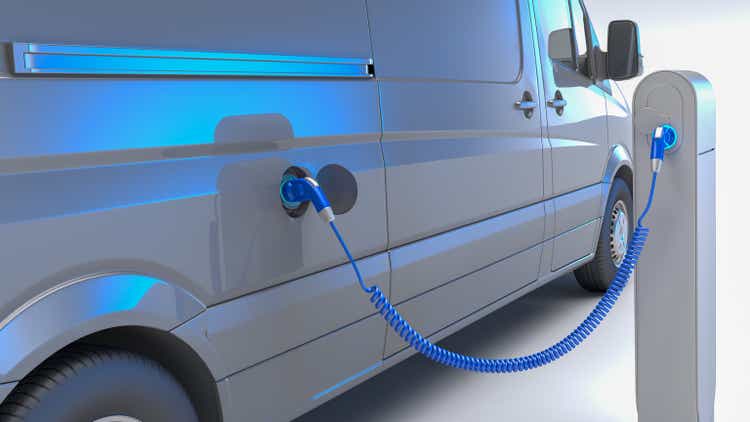Will Arrival Survive? (NASDAQ:ARVL) | Seeking Alpha

Franck-Boston
Earlier today, Arrival Group (NASDAQ:ARVL) updated investors about its financial position and business plans for the coming quarters, which weren’t particularly good as the company is running out of cash and is unable to raise funds.
Background
As I’ve covered in a previous article, Arrival is a speculative play in the electric vehicles (EV) sector, which has great ambitions to disrupt the automotive industry by betting on a different production approach, through smaller, automated factories.
However, since it became a public company in 2020, following the merger with a SPAC company, its equity story has gone from bad to worse. While at some point during 2021 its market value was close to $13 billion, this figure is only about $250 million now, which is less than the company’s cash on hand at the end of September.
As Arrival continues to burn cash and funding conditions are tough for start-ups, the company has changed its business targets several times and has not delivered on any of the targets it established during the SPAC listing.
More recently, in its Q2 2022 earnings release, the company slashed its deliveries target for this year, from about 600 vans to just 20, being another blow to its investment case. While investors, myself included, believed next year could be different as production was supposed to begin and revenue coming in, Arrival has again changed its business strategy and now doesn’t expect any revenue in 2023. As the company does not have enough cash to finance its operations over the next twelve months, there is a high likelihood that Arrival will go bankrupt in the coming months.
Recent Developments
Arrival released Q3 2022 earnings today, reporting a loss of $310 million in the quarter, including non-cash impairment charges and write-offs of $232 million. Adjusted EBITDA loss was $73 million, compared to a loss of $46 million in the same quarter of last year.
More important than its earnings, Arrival also updated investors on its business plans for the coming quarters, as the company tries to remain in business after significantly revising its targets downward over the past few quarters.
Investors should note that Arrival was expecting to produce three models (the van, bus, and a car) by 2024, but some months ago changed its strategy to focus only on the van. Because of that, it was expected to produce only the van at the Bicester (UK) factory, while the planned U.S. factory was put on hold. Supposedly, it was expecting to start production during Q3 2022, and to start deliveries to customers in the following months.
Additionally, the company announced several measures to cut costs and was expecting to raise funds through an at-the-market (ATM) offering, which would allow the company to have enough cash to fund its operations until the end of 2023.
However, during the past quarter, Arrival decided to not raise funds through the ATM platform due to a low share price, which was needed to invest in hard tooling. This means that Arrival does not have enough capital to invest in machinery to produce the van, which was critical for its success.
Moreover, the company has changed its business strategy again and now is shifting its focus toward the U.S. market instead of Europe, as it sees this market as more attractive following the introduction of the Inflation Reduction Act tax credits for commercial electric vehicles. The company is now targeting the U.S. to enter production, using its cash resources and further funding that it may eventually raise.
This means that Arrival will make several cuts at its Bicester factory, leading to about 700 jobs being cut across the company or some 30% of its workforce, to save cash and try to survive over the next few quarters. This is not an easy task, as Arrival does not expect to generate any revenue during 2023, thus it relies on external funding or it will run out of cash in the coming quarters.
Investors should note that Arrival had about $500 million of cash available at the end of June, while at the end of September it had only $330 million. For the end of the year, Arrival expects to have between $160-$200 million of cash, as the company will incur some $75 million in restructuring costs during Q4 that will reduce its available cash.
While its cash burn in 2023 may be lower on a quarterly basis, it seems likely that Arrival will run out of cash by mid-2023, if it is not able to raise external funding. Not surprisingly, Arrival’s shares are down today by more than 35% as I write this, to a new all-time low.
Investors should also note that Arrival has recently received a notification from the Nasdaq that it is not complying with certain listing rules, given that its share price closed below $1 for more than thirty consecutive days. This means that Arrival also faces the risk of de-listing over the coming six months, if its share price does not recover above $1.
Conclusion
As I’ve said in my previous article, Arrival was in a critical stage for its business success, with the start of production being key to show that its business model worked. Arrival does not have a proven manufacturing process and during the past quarter failed to get enough funding to go ahead with its plans, and its business prospects are now very poor.
Its investment case right now is based on basically a concept, as the company does not have enough cash to build a factory in the U.S., thus I don’t see how it will get enough funding over the coming months to stay afloat. Arrival is very likely to go bankrupt in the coming months, as funding conditions on capital markets aren’t likely to change much in the short term.


